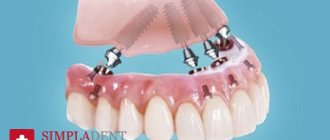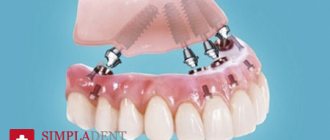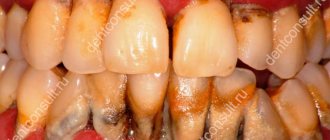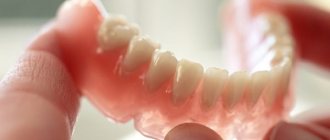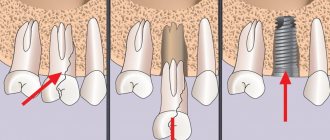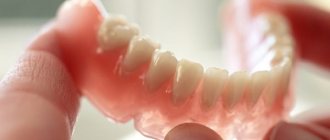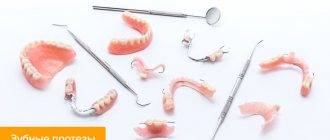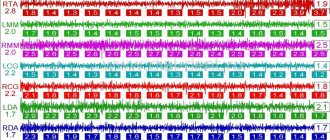Implantation using the All-on-4 method (literal translation “all on four”) allows you to restore the teeth of one jaw on 4 implants in 1 day: 2 outer titanium rods are installed at an angle of up to 45 degrees, bypassing the maxillary sinuses on the upper jaw and the exit site of the nerve on the lower jaw. There is no need to perform additional osteoplastic operations. It is possible to restore teeth in the shortest possible time - immediately after the operation a temporary fixed prosthesis is installed.
Who is All-on-4 suitable for?
- People who have no teeth or very few teeth left.
- For periodontal disease (periodontitis) of all teeth.
- Patients who want to avoid bone grafting.
- For those who want to get new teeth in 1 day.
All-on-4 implantation - technology features
This is a technology for restoring dentition using an accelerated method for those who have lost their teeth completely or are missing a significant part of them. On the day of treatment (if there are no specific contraindications), 4 implants are implanted into the jaw within 1.5-2 hours. Two of them are located vertically in front, the rest are located on the side at an angle of 45⁰. The inclined position ensures reliable fixation of the prosthesis in the oral cavity, since the area of contact of the titanium pin with the bone tissue increases.
After installing the implants with abutments, a temporary acrylic prosthesis is attached to them. Its service life usually ranges from 3 months to six months - it is during this time that artificial roots take root. The reinforced metal-plastic adaptation structure can be used for up to 3-4 years. A permanent bridge is made of zirconia, ceramic or ceramic composite. The latter option is characterized by increased strength and durability - its service life reaches 20 years.
What is the difference between a prosthesis on 4 implants and classical methods of dental prosthetics? This technique has several obvious advantages:
- speed of treatment - you can install a prosthesis in one visit to the dentist, spending only a few hours;
- high survival rate - in 99% of cases titanium pins are not rejected (the most effective result in comparison with other types of prosthetics);
- comfort - adaptation to the design occurs quickly, in just 1-2 days, during the process of adaptation, diction is not impaired, and the mucous membranes of the oral cavity are not injured;
- minimum contraindications and restrictions - the technology allows you to restore the dentition of people who have lost all their teeth, including people over 80 years old, patients with bone tissue dystrophy, and periodontal diseases;
- aesthetics - an artificial jaw does not differ in appearance from a real one, it looks natural and attractive;
- safety and atraumaticity - soft tissues and bones are not injured during implantation, and preliminary maxillofacial surgeries and osteoplasty are also not required.
Features of the All-on-4 implantation procedure
The traditional All-on-4 procedure boils down to the following:
- After studying the OPTG and CBCT data, the dentist determines the best places to install the DI;
- The operation begins with anesthesia and the formation of a folding mucoperiosteal flap;
- A standard template is applied to the jaw, according to which the doctor determines the places for screwing in titanium supports;
- Two implants are installed in the frontal area strictly vertically in relation to the jaw;
- The remaining two implants with multi-units are installed obliquely at an angle of 35-45 degrees in the lateral areas - one on each side of the jaw;
- The flaps are returned to their places, the wounds are sutured;
- The operation is completed by screw fixation of a temporary acrylic prosthesis to the established DI for up to 6 months;
- After 10-12 days, the sutures are removed and the temporary prosthesis is returned to its place;
- After the period of complete osseointegration of the implants, a complete removable denture (no more than 12 units) is made from acrylic or with a titanium or zirconium bar lined with ceramics. In addition, there are possible options for prosthetics with fixed bridge structures or conditionally removable products with locking fasteners.
The inclination of the DI provides a larger area of contact of the titanium root with the bone, especially with its cortical layer, due to which the future fixed prosthesis will be more stable in the oral cavity, and important maxillofacial structures (maxillary sinus or mandibular nerve) are not affected.
A permanent prosthesis has a base that completely covers gum defects formed due to a long absence of teeth. It is for this reason that there is no need for bone grafting and gingivoplasty (surgery to increase the height of the gums).
More advanced, but also technically complex, is the implantation procedure using an individually modeled 3D surgical template, which is printed and applied to the jaw before the operation. This ensures maximum accuracy of DI placement. The protocol can be performed either with a flap detachment or using a flapless technique, i.e. through gum punctures.
Work examples
How often do you visit the dentist?
Who is All-on-4 technology suitable for?
All-on-4 implantation is the optimal way to restore both the upper and lower dentition in cases of complete edentia or the absence of a significant number of teeth. Fixed dentures, unlike removable dentures, look more natural, last much longer, do not impede diction and eating, and are securely fixed in the oral cavity.
This technology is also suitable for people who value their time. Classic implantation requires regular visits to the dentist for six months or more. In this case, visible results are achieved only at the end of treatment. A prosthesis on 4 implants is installed in just a few hours without pain or discomfort.
Dental prosthetics using the all on 4 method is indispensable when there is insufficient bone tissue. After tooth extraction, the jaw atrophies in just 2-3 months, and the installation of a classic implant requires osteoplasty - bone augmentation. This operation is not necessary when installing an “All-on-4” prosthesis. In addition, the fixed design is an excellent alternative to a removable denture if it needs to be replaced.
The benefits of this method will also be appreciated by people with periodontal diseases. In case of inflammation of the periodontal tissues, or the presence of loose or untreatable teeth, only the technology under consideration can restore the dentition completely.
All-on-4 implantation is suitable for the absence of most teeth and complete edentia
Indications for using the “All on 4 implants” technology
Despite all the advantages of the technique, it is not always advisable to use it. It is used if the installation of individual implants is not possible. Such cases include:
- edentia (partial or complete);
- chronic periodontitis;
- lack of bone tissue and the inability to build it up;
- discomfort from wearing removable structures.
Contraindications to the operation are the following factors:
- elevated blood sugar levels;
- endocrine pathologies;
- post-traumatic period;
- allergy to certain types of plastic.
Contraindications
Relative contraindications to all on 4 implantation are inflammatory diseases of the oral mucosa and caries. After sanitation, implants can be installed.
It is strictly forbidden to do prosthetics using this method if the patient is diagnosed with:
- oncological processes in the body;
- blood diseases;
- inflammation in the acute phase of any localization;
- diabetes;
- drug addiction;
- tuberculosis;
- exacerbation of mental pathology.
Cost of implantation “all on six”
In terms of price - all-on-6 dental implantation will be more expensive than implantation of 4 implants (all on four). An operation, including diagnostics, surgical stage and installation of a temporary prosthesis, can cost the patient 240-250 thousand rubles. Permanent prosthetics are not included in the indicated price and are paid separately. The price of all-on-six implantation will mainly be influenced by the price of the implantation system. The most expensive option is implants from Nobel, but if you wish, you can find more budget-friendly alternatives in the lines of other brands.
It is better not to save money on all-on-6 implantation and not to go to dubious clinics offering the service at a suspiciously low price. It is important to remember that dental implantation is a serious surgical intervention, which means its success will depend not only on the type of implants, but also on the qualifications of the implantologist. Our dental clinic in Moscow “VENSTOM” employs experienced and competent implantologists who have been trained by manufacturers of implant systems and received the appropriate certificates. Therefore, we are ready to guarantee high quality dental implantation to each of our patients!
Advantages and disadvantages of All-on-4 implantation
Before deciding to install implants, it is necessary to analyze all the advantages and disadvantages of the technique. The advantages of the technology include:
- there is no need to carry out preliminary maxillofacial operations or build up bone tissue;
- installation of implants and prosthesis is carried out within 1 day, even immediately after tooth extraction (pins can be fixed both in the hole and nearby);
- all manipulations are low-traumatic and are performed under anesthesia, so no discomfort or pain is felt either during the procedure or after it;
- the placement of the side implants at an angle ensures reliable fixation of the prosthesis and uniform distribution of the load on the jaw;
- all on 4 implantation is the prevention of bone tissue atrophy (unlike removable structures);
- from an aesthetic point of view, “all-on-4” dentures are better than many analogues - they look as natural as possible and improve diction;
- accessibility – in case of severe or complete edentia, restoring the dentition using this method will cost many times less than classical two-stage implantation.
There are also disadvantages, but they are much fewer. The list includes allergic reactions to the material from which the prosthesis is made (rare), the presence of absolute contraindications.
The possibility of implant failure cannot be ruled out. However, it should be remembered that when contacting experienced specialists (and these are the ones who work in our clinic), this risk is less than 1%.
Dentures look aesthetically pleasing and are practically indistinguishable from real teeth
Features and advantages of All-on-6 dental prosthetics
The method is recommended for moderate jaw bone loss and compensates for the disadvantage of the All-on-four dental implantation There are 6 implants per jaw, so the prosthesis is fixed more securely and the load is distributed more evenly.
- High-strength, one-piece implants of a special design with a specific type of thread are used. They are highly sterile, therefore minimizing the likelihood of infection at the surgical site. This means that the technology can be recommended to patients with inflamed periodontal tissue.
- Two implants are implanted vertically in the frontal section of the dentition and two each in the lateral sections, but not in the central spongy layer of the bone, but in the deeper sections - more dense and practically not subject to atrophy.
- The implant is screwed into the bone like a self-tapping screw through a puncture in the gum. The tissue is practically not injured, and there is no need for sutures. For direct, even fixation of the prosthesis, the abutment is tilted at a pre-calculated angle.
What implants and prostheses are used?
The “all on 4 implants” prosthetic technology was developed and introduced into global dental practice by the American company Nobel Biocare. Since then, the components of this brand have been considered the standard of quality. However, over the twenty-year period of use of the technique, many worthy analogues have appeared, produced by domestic and foreign enterprises.
Implants
The YuliSTOM dental clinic in St. Petersburg offers a wide range of titanium pins and abutments from different manufacturers for installation. The patient can choose the most suitable option in terms of quality and cost from the following brands:
- Rusimplant are universal orthopedic elements of the ConeFit system, produced in Russia using German technologies. Made of Grade 5 (titanium) alloy, corrosion resistant, highly compatible with biological tissues, lightweight and durable.
- Superline is a Korean middle-class prosthetic system made of Grade 4 alloy with a conical connection type.
- Nobel is the standard of all on 4 implantation components from the technology developer. Design features - different types of threads, a special microporous Ti-Unite surface, ensuring almost 100% engraftment, Grade 4 alloy (ultra-pure titanium).
- Straumann - are distinguished by a unique Roxolid alloy (titanium with zirconium dioxide) and a hydrophilic surface. These features of Swiss pins reduce the time of osseointegration to one and a half months.
- Prodigy is a product of BioHorizons Implant Systems, Inc., USA. They take root well due to the unique Laser-Lok surface and microchannels located on the neck of the titanium root.
- Adin Implant - implants made in Israel, characterized by a relatively low survival rate and outdated design. Made from Grade 5 titanium alloy with aluminum and vanadium.
- Hi-Tec Implant - in terms of properties and design, the products of the Israeli brand are as close as possible to the original Nobel implants. This explains the rather high rates of osseointegration.
The table contains brief basic information about each type of implant:
| Name | Class | Survival rate, % | Guarantee | Price, rub |
| Nobel | premium | 99,3 | for life | 198 000 |
| Superline | average | 98,2 | 120 000 | |
| Straumann | premium | 99,7 | 200 000 | |
| Adin Implant | average | 85 | 90 000 | |
| Hi-Tec Implant | average | 92 | 110 000 | |
| Prodigy | average | 97,5 | 115 000 | |
| Rusimplant | economy | 85 | 15 years | 50 000 |
Prostheses
After selecting the appropriate type of titanium roots, it is necessary to select fixed prostheses on 4 implants, as well as an adaptive (temporary) design. Manufacturers offer four main types of artificial teeth. The best option is metal-ceramic products from the Nobel company, the best acrylic bases are produced by the German brand Heraeus Kulzer, and crowns are produced by the Japanese company Yamahachi.
- Metal-free base with acrylic or zirconium dioxide crowns. The base of the artificial jaw is made of zirconium dioxide, which allows you to evenly distribute the load on the gums and give additional strength to the bridge. However, to reduce the cost of construction, a fiberglass frame lined with ceramics can be used. The product is quite durable - its service life is about 10 years.
- Metal-free crowns made of zirconium dioxide or acrylic. In the first case, the design is more durable and looks as aesthetically pleasing and natural as possible. Artificial teeth made of acrylic are cheaper, but they look less natural and wear out faster (their service life is limited to 5 years).
- Metal ceramics. A metal-ceramic prosthesis with a titanium beam is an expensive option characterized by increased strength. It is indispensable in the case of elongated side consoles of the structure. Among the disadvantages, one can note reduced aesthetics, since the titanium frame gives the ceramic a grayish tint. The cheaper option is not a titanium alloy, but a cobalt-chromium alloy (CHC), but it will weigh more.
- Milled titanium base with acrylic prosthesis. Beam prosthesis on 4 implants, with a hot polymerization plastic base from the German manufacturer Heraeus Kulzer. The base is elastic and impact-resistant. Yamahachi acrylic crowns made in Japan are characterized by increased strength and wear resistance. The milled titanium base ensures uniform load on the jaw.
- Acrylic prosthesis. Orthopedic design made of acrylic obtained by processing under high pressure at high temperatures. This technology will reduce the amount of monomer in plastic and reduce the risk of an allergic reaction. The advantages include a relatively low cost, and the disadvantages are low strength indicators and rapid wear of the crowns.
Turnkey cost in Moscow
The price for implantation using the All on 4 protocol depends on the brand of materials and pricing of a particular dentistry. Many Moscow clinics offer turnkey implantation, which means a fixed cost of services. Usually included in the price:
- implants of a specific brand;
- abutments;
- temporary adaptive prosthesis;
- implantologist services;
- orthopedic services.
The final amount depends on the characteristics of the preparatory stage, the chosen method of pain relief, and the material of the permanent prosthesis. Expenses for the listed services, as a rule, are not included in the fixed price. It is important to clarify the list before signing the contract.
You can restore all your teeth at a discount as part of promotions and special offers, which are also often offered by Moscow clinics. Some medical institutions offer the opportunity to pay for treatment in installments.
How is All-on-4 dental implantation performed and how long does it last?
All on 4 implantation is carried out in several stages, the longest of which is preparatory. Direct installation of pins and prostheses takes only a few hours. Soft tissues heal within a week; osseointegration of implants requires an average of 3 to 6 months (premium models take root faster).
Preparation for implantation includes several stages
Preparatory stage
Before installation of implants and artificial jaws, the patient must undergo a thorough examination to exclude complications. The list of diagnostic measures includes:
- Initial appointment and examination. The implant surgeon visually assesses the condition of the gums and teeth and collects anamnesis. Based on the data obtained, recommendations are given on the choice of implants and prostheses, and the preliminary cost of treatment is announced.
- Comprehensive diagnostics. The most important study is computed tomography, which evaluates the location of nerves, vessels and maxillary sinuses, and determines the characteristics of bone tissue (its density, width, height). In addition, CT reveals hidden pathologies - various types of neoplasms, cysts. To assess the condition of the temporomandibular joint, condylography is performed. To make adaptive and permanent dentures, the doctor makes a cast of the jaws.
- 3D modeling. The information obtained during the diagnostic examination is processed by a special program. The result is a three-dimensional model of the jaw, which allows you to create a digital template - visualization of treatment. 3D modeling is necessary to determine the location of fixation of titanium pins and prototyping fixed prostheses on 4 implants.
- Sanitation. Before installing artificial teeth, you need to cure your own teeth from caries, clean them of tartar and plaque. If there are pockets of infectious inflammation in the oral cavity, they also need to be eliminated. These procedures are necessary to prevent complications (inflammatory processes) after implantation.
Surgical stage
Before the procedure begins, anesthesia is administered. Anesthesia can be local or general (in the second case, the patient will not feel anything at all, as he will be asleep). After premedication, the surgeon begins the implantation procedure:
- Untreatable, loose teeth, as well as infected areas of soft tissue are removed.
- In one of two ways – transgingival or flap – titanium pins are inserted into the jaw. The first method is minimally invasive; the implant is fixed through a small puncture in the gum. In the second case, the mucous membrane is incised.
- After completion of the manipulation (on average after 1.5 hours), the wounds are sutured.
Orthopedic stage
The final stage of the “all on 4 implants” method of restoring the dentition. The dentist takes impressions that are needed to make a permanent orthopedic structure. Then abutments are installed on the pins - straight in front and angled on the sides, and then the temporary prosthesis is fixed to them using special screws.
Delayed installation of artificial teeth is also practiced (at the patient’s request) - after the mucous membrane has healed and the sutures have been removed a few days later. After completion of the osseointegration process, which usually lasts from 3 to 6 months, the adaptive orthopedic design is replaced with a permanent one. If a reinforced bar prosthesis is used, replacement can be delayed for up to 3-4 years.
Rehabilitation and care
In the postoperative period, you must visit the dentist according to a pre-agreed individual schedule. Within a week, the sutures are removed and the condition of the soft tissues is assessed. A repeat visit is recommended after a month and a half for those who live near the dental clinic. For out-of-town patients, a delay in visiting a doctor is allowed for up to three months.
The first time after surgery you need to visit the dentist regularly
Pain and swelling in the first days are normal, and they are insignificant, since all manipulations are minimally invasive and are performed by professionals working in our clinic. To eliminate pain, the doctor may recommend taking analgesics, and to prevent inflammation, a course of antibiotics is prescribed. At the same time, the functionality of the prosthesis on 4 implants is assessed. If the patient experiences significant discomfort, the position of the artificial jaw is adjusted. In addition, in the early recovery period there are a number of restrictions associated with habits and lifestyle:
- You should not eat hard, sticky, difficult to chew or too sour foods;
- It is forbidden to drink too hot or cold drinks;
- you should limit physical activity, do not visit the sauna, bathhouse;
- do not use rinses or toothpastes containing fluoride;
- avoid traumatic sports.
During the rehabilitation process, it is important to properly care for the oral cavity and the orthopedic structure itself. Since the base of the denture does not fit tightly to the gum, plaque from food debris and bacteria will form in the resulting space.
Once every six months, professional cleaning of the prosthesis is necessary. The doctor removes the structure, removes plaque from it, and then polishes it. If daily hygiene is insufficient, as evidenced by bad breath, you will have to visit the clinic at least once every 3 months. In addition, acrylic and porcelain composite teeth must be replaced every few years due to wear.
For high-quality cleansing at home, you will need special threads - super-flosses, as well as an irrigator and rinses. In addition, artificial teeth need to be cleaned regularly with a toothbrush.
Features of the classic protocol
Classical implantation is a two-stage process: in the first stage, implants are implanted, in the second, a prosthesis is installed. Between stages, a certain amount of time passes, necessary for the fusion of titanium roots with the jawbone. Implantation of titanium roots occurs using the patchwork method - the doctor cuts the gum, folds back the mucous flap, forms a hole in the bone into which the root-like implant is screwed and sutured the wound.
After complete osseointegration (after 3-6 months), the gum is cut again, and a gum former is fixed to the implant to achieve the desired aesthetics of the gingival margin. After 10-14 days, the former is replaced with an abutment, onto which a permanent prosthetic structure is attached. In case of bone atrophy, before installing a titanium root, it is necessary to do directed osteoplasty (on the lower jaw) or sinus lift (on the upper jaw).
Possible complications
It must be taken into account that after implantation, complications may develop, the most likely of which are:
- implant rejection – occurs due to biological incompatibility of living tissues with the metal of the structure;
- peri-implantitis is a purulent inflammatory process provoked by infection;
- pain – headaches, as well as localized in the area of implants, temporomandibular joint;
- swelling of the soft tissues, minor bleeding is the norm in the early postoperative period, but if these phenomena are protracted, they are a sign of pathology;
- an unpleasant odor is usually a consequence of improper care of an artificial jaw with 4 implants.
To exclude post-implantation complications, three conditions must be met. First, choose high-quality implants with prostheses from reliable well-known manufacturers. Secondly, contact dental clinics where highly qualified implant surgeons work, like in Yulisty. Thirdly, take proper care of the orthopedic structure - clean it regularly, use an irrigator, and come for professional cleaning on time.
When urgent help is needed
Normally, pain and swelling of the gums disappear a few days after the procedure. Headaches or discomfort in the temporomandibular joint may occur due to atrophy of the masticatory muscles after a long period of absence of teeth. As a rule, they also pass quickly after restoration of muscle function. However, in some cases, urgent medical intervention is necessary:
- prolonged bleeding - can be caused by damage to blood vessels during surgery;
- increasing swelling and pain, increased temperature - signs of an inflammatory process;
- discharge of fluid from the nose is a consequence of damage during implantation of the maxillary sinuses;
- numbness of the jaw is the result of cutting or pinching of the conductive nerves during the installation of implants.
What is complete edentia?
It is generally accepted that the complete absence of teeth on one or both jaws is typical for older people who, in accordance with age-related changes, experience tooth loss. However, in medicine, “complete adentia” is a diagnosis that can be made to a person at any age. The causes of the pathology may be different.
Causes
Complete edentia has two forms: primary and secondary. The primary form of the disease includes disturbances in the development of tooth buds even at the stage of formation of fetal organs in the womb.
The anomaly can be provoked by ectodermal dysplasia or other hereditary pathologies, as well as factors affecting the body of a pregnant woman:
- endocrine system disruption;
- action of teratogenic factors;
- lack of minerals;
- infections;
- bad habits (alcohol, drugs, etc.).
Secondary complete adentia is much more common. As a rule, a pathological condition occurs due to certain reasons:
- lack of timely treatment of dental diseases that lead to damage to one or more teeth with their subsequent removal;
- diseases of the soft or bone tissues of the oral cavity, causing purulent processes, inflammation of the gums, weakening of ligaments or damage to the jaw bones;
- errors by a specialist in the treatment of diseases of the teeth, gums or jawbone;
- congenital anomalies of the development of teeth or jaw, requiring the removal of all units of the dentition;
- mechanical injuries of the jaw;
- systemic diseases causing immunodeficiency or their treatment;
- age-related changes (natural process);
- taking certain potent drugs.
Implantation in the absence of teeth is considered the best solution for the complete reconstruction of the entire dentition. Thanks to implants, the structure is securely fixed to the jaw, eliminating the need for permanent installation with special means and the risk of its falling out.
Is there an alternative to All-on-4
If for some reason prosthetics using the “all on 4 implants” technology cannot be performed, the patient is offered an alternative option.
All-on-3
This technique from Nobel Biocare is used only to restore the dentition of the lower jaw. The operation - surgical and orthopedic stages - lasts about 6 hours. There are two differences from the all-on-4 technology. The first is the number and method of fixing the implants: three support pins are used (one in the center, two on the sides). The second is the possibility of installing a permanent orthopedic structure made of acrylic immediately. Due to these features, the cost of treatment is significantly reduced.
All-on-3 or Trefoil implantation
All-on-6
Suitable for prosthetics of the lower or upper jaw (or both) in the absence of teeth. It is optimal in case of significant lack of bone tissue, its low density, as well as in case of periodontal diseases and bruxism (increased tone of the masticatory muscles). The adaptation prosthesis is fixed on 6 implants on the day of surgery (single-stage technology) or after 3 days. Due to the increased consumption of materials, the procedure is more expensive.
Classic two-step protocol
It is distinguished by its duration and high prices. Before implantation, osteoplasty is required - bone tissue augmentation and sinus lifting (correction of the maxillary sinuses). This stage lasts 4-5 months, after which implants are implanted for each tooth. Osseointegration will take another 1-2 months, and only then the doctor will install abutments with crowns. The cost of this technique exceeds the cost of implantation per day all-on-4 and its analogues.
The table provides a brief comparative description of popular dental implantation techniques. The price for the two-stage protocol is minimal, using the cheapest materials.
| Name | Duration | Traumaticity | Osteoplasty | Total cost, 1 jaw |
| All-on-4 | 1 day | low | Not required | 400 000 |
| All-on-3 | low | 300 000 | ||
| All-on-6 | average | 500 000 | ||
| Two-step protocol | From 6 months | high | Mandatory | From 600,000 |
Types of implants and their installation
Nobel Biocare has developed three types of endoprostheses that are fundamentally different from each other:
- NobelParallel Conical Connection is a titanium support suitable for most patients with single, multiple defects and complete absence of teeth in the jaw. Implants are available in cone-shaped shapes in several sizes, which allows them to be installed on both the front and side areas of the jaw with different types of bone. Suitable for direct implantation with immediate loading.
- NobelSpeedy are original implant prostheses with different thicknesses and lengths of the body and neck, designed for immediate implantation. They can be used in moderately dense and soft bones, because... The line includes options for bicortical fixation. The special thread promotes rapid osseointegration and stabilization of titanium supports.
- NobelZygoma – used as distal implants for the upper jaw with severe atrophy of the alveolar process. The place of fixation is the zygomatic bone, which is an excellent alternative to bone grafting. This type of endoprosthesis has several options for miltiunites (abutments) with an angle of inclination from 30 to 60 degrees and is suitable for immediate loading of the prosthesis.
How much does All-on-4 implantation cost?
When planning the cost of prosthetics using the “all on 4 implants” technology, you should take into account that the final cost is always calculated individually. The prices listed on the website are approximate, since the final amount for treatment is determined by a combination of several factors. These include:
- The severity of the clinical case. The degree of edentia, the condition of the remaining teeth and soft tissues significantly affect the price of prosthetics. The need for large-scale treatment at the preliminary stage increases it.
- A variety of titanium implants, as well as adaptive and permanent orthopedic structures. The more famous the manufacturing company, the better and more expensive the materials (they take root easier and last longer).
- Qualification, experience, regalia of an implant surgeon. The services of a high-class professional are always expensive, since in this case the quality of prosthetics and the absence of postoperative complications are guaranteed.
- Costs for replacing prosthetic elements. Crowns wear out over time and need to be replaced periodically. Acrylic - once every 4-5 years (with a 2-year warranty), metal-ceramic - less often. In this case, accidental breakdowns and damage to the structure may occur after the warranty period has expired. In such cases, maintenance costs also increase.
It should also be taken into account that hygienic care of an artificial jaw will also require material costs. If it is enough to simply clean a removable denture with a brush every day, to maintain fixed structures you will have to additionally spend money on super-flosses and an irrigator.
Types of implants used in Face Smile
The choice of the implant manufacturer and the material from which it will be made is individual and depends on the specific case of each individual patient, including the anatomy of his oral cavity, chronic diseases, individual intolerance to certain components and many other factors, including the qualifications of the attending physician and the technical equipment of the clinic .
At the Face Smile Center, maxillofacial surgeons work only with high-quality implants from the world's best manufacturers. We use the following types of implants: Osstem TSIII SA, Hi-Tec, MIS, Xive, 3i, Straumann, Astratech, Nobel Parallel, Nobel Active, Zygoma.
Thus, MIS implants are ideal for immediate implantation. Titanium alloy is used in their manufacture. Aluminum and vanadium impurities give the implant even greater strength. The MIS line of implants is suitable for patients with both soft and hard types of bone tissue.
The titanium rod of Osstem implants is processed in a special way - the SMR method. This processing makes it possible to imitate the structure of human bone as closely as possible. Osstem rods very quickly become overgrown with tissue and take root after installation.
In the production of Hi Tech implants, modern medical grade 4 titanium alloy is used. Special surface treatment technologies guarantee almost complete absence of reaction to the presence of a foreign object.
Premium Nobel implants have been the most popular in the USA and European countries for more than 50 years. One of the success factors of implants is their surface made of a thickened layer of titanium dioxide with a high phosphorus content. Nobel implants have improved biocompatibility, accelerated osseointegration and high strength.
Zygoma zygomatic implants are long-length structures. They are installed not in the jawbone, but in the zygomatic bone. This is an alternative to short implants, angled implants, and bone grafting. These implants are made of high purity titanium. Their special porous coating quickly fuses with the bone. Due to their high initial stability, a temporary fixed prosthesis can be placed on them on the very first day.
